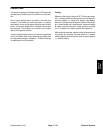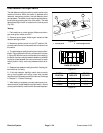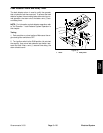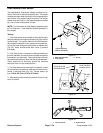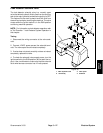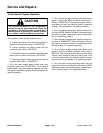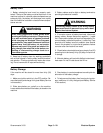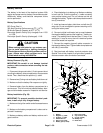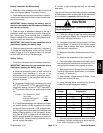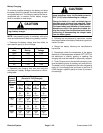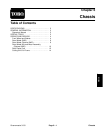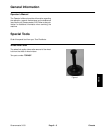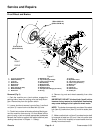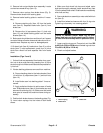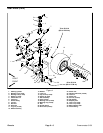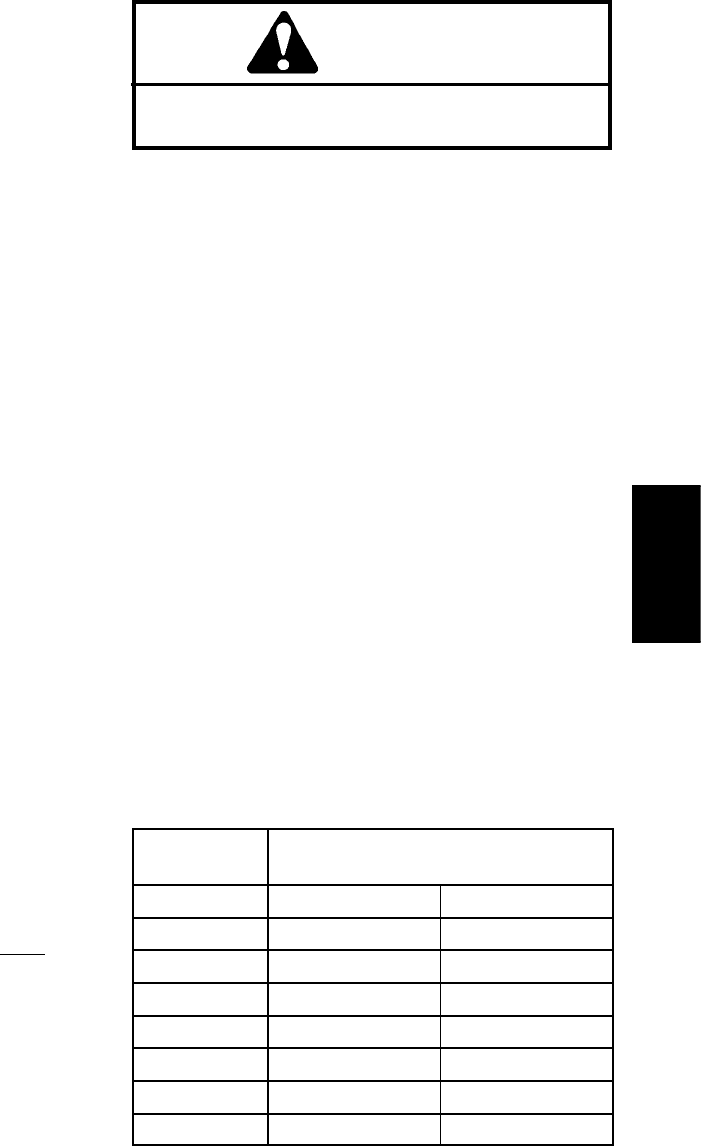
Greensmaster 3150 Page 5 -- 31 Electrical System
Battery Inspection and Maintenance
1. Check for cracks caused by overly tight or loose hold
down rod. Replace battery if cracked or leaking.
2. Checkbattery terminal posts forcorrosion. Usea ter-
minal brush or steel wool toclean corrosion from thebat-
tery terminal posts.
IMPORTANT: Before cleaning the battery, tape or
block the vent holes to the filler caps and make sure
the caps are on tightly.
3. Check for signs of wetness or leakage on the top of
the battery which might indicate a loose or missing filler
cap, overcharging, loose terminal post or overfilling.
Cleanthebatterywithasolutionofbakingsodaandwa-
ter, then rinse it with clean water.
IMPORTANT: Make sure the a rea around the cells is
clean before opening the battery caps.
4. Check the electrolyte level in each cell. If necessary,
fill all cells with distilled water to the bottom of the cap
tubes. Charge at 15 to 25 amps for fifteen (15) minutes
to allow sufficient mixing o f the electrolyte.
Battery Testing
1. Conduct a hydrometer test of the battery electrolyte.
IMPORTANT: Make sure the a rea around the cells is
clean before opening the battery caps.
A. Measure the specific gravity of each cell with a
hydrometer. Draw electrolyte in and out of the
hydrometer barrel prior to taking a reading to warm--
upthehydrometer.Atthesametimetakethetem-
perature of the cell.
B. Temperature correct each cell reading. For each
10
o
F(6
o
C) above 80
o
F(27
o
C) add 0.004 to the spe-
cificgravity reading.For each 10
o
F(6
o
C) below 80
o
F
(27
o
C) subtract 0.004 from the specific gravity read-
ing.
Example: Cell Temperature 100
o
F
Cell Gravity 1.245
ADD (20
o
above 80
o
F) 0.008
Correctionto80
o
F 1.253
C. If the difference between the highest and lowest
cell specific gravity is 0.050 or greater or the lowest
cellspecific gravity is less than 1.225,charge the bat-
tery. Charge at the recommended rate and time (see
Battery Charging below) or until the specific gravity
of all cells is 1.225 or greater with the difference in
specific gravity between the highest and lowest cell
less than 0.050. If these charging conditions can not
be met, replace the battery.
2. Perform a high--discharge test with an adjustable
load tester.
Thisisone ofthe mostreliablemeans of testing a battery
as it simulatesthe cold--cranking test. Acommercial bat-
tery load tester is required to perform this test.
CAUTION
Follow the manufacturer’s instructions when us-
ing a battery tester.
A. Check the voltage across the battery terminals
prior to testing the battery. If the voltage is less than
12.0 VDC, recharge the battery.
B. If the battery has been charged, apply a 150 amp
load for fifteen (15) seconds to remove the surface
charge. Use a battery load tester following the
manufacturer’s instructions.
C. Make sure the battery terminals are free of corro-
sion.
D. Measure the temperature of the center cell.
E. Connect a battery load tester to the battery termi-
nals following the manufacturer’s instructions. Con-
nect a digital multimeter to the battery terminals.
F. Applya test load of 270 amps (one half the battery
Cranking Performance Specification) to the battery
for fifteen (15) seconds.
G. Take a battery voltage reading at fifteen (15) se-
conds, then remove the load.
H. Using the table below, determine the minimum
voltage for the cell temperature reading.
Minimum
Voltage
Battery Electrolyte
Temperature
9.6 70
o
F (and up) 21
o
C (and up)
9.5 60
o
F 16
o
C
9.4 50
o
F 10
o
C
9.3 40
o
F 4
o
C
9.1 30
o
F -- 1
o
C
8.9 20
o
F -- 7
o
C
8.7 10
o
F -- 1 2
o
C
8.5 0
o
F -- 1 8
o
C
I. If the test voltage is below the minimum, replace
the battery. If the test voltage is at or above the mini-
mum, return the battery to service.
Electrical
System



